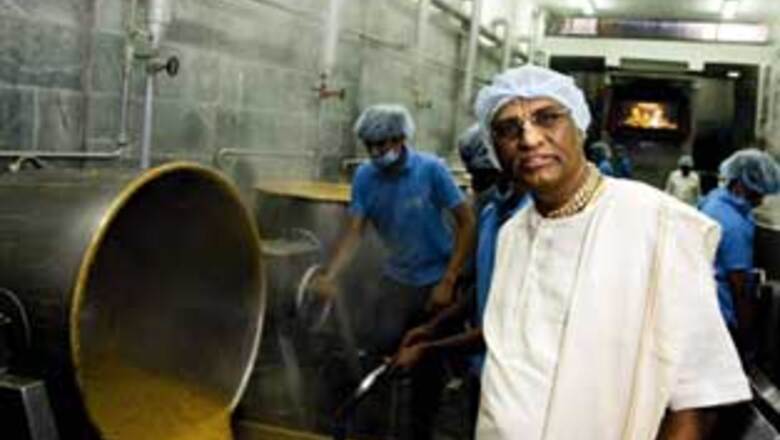
views
As the clock strikes noon, the hungry murmur of the children at the government school in Frazer Town, Bangalore, is broken by the arrival of the blue pick-up truck. The kids chorus “Akshaya Patra” as large stainless steel vessels are unloaded from it and the call for lunch goes out. Most of these children are from families where a square meal is not guaranteed every day.
But on this occasion, there is the piping hot sambar rice and the cool, rich curd rice to feast on. There is no bar on how much each child could eat. Thirty minutes later, each kid returns to the class 500 calories richer and the truck leaves with a promise to return the next day.
In a country where 47 per cent of children are underweight and school drop-outs are often linked to poverty, providing good quality food on a large scale across the school network is not just a noble effort in charity but a smart investment in its economic future. But to do this every day for a million children in six states takes a mini miracle. That’s what Akshaya Patra (Sanskrit for “the vessel that never goes empty”) has achieved so far. And if things go according to plan, this initiative from Bangalore will cover five million children, and give the nation a sound model to counter both malnutrition and illiteracy.
The mission started serendipitously one day in 2000. Mohandas Pai, the then chief financial officer of Infosys Technologies, was visiting the Krishna temple of the International Society for Krishna Consciousness (ISKCON) in Bangalore. Located on a hillock and paved liberally with marble, the temple also runs a mega kitchen that serves hundreds of thousands of devotees with sumptuous food offered to the Lord. When he saw this, Pai wondered: What if the temple could make a little extra to feed the children in nearby schools? “The most fundamental need of a human being is food,” says Pai. “If society can’t guarantee that, there is no need to build edifices on top of that.”
Pai, who had made a tidy sum from his stock options at Infosys, had already been looking for a good cause to contribute to. Years earlier, he had heard about the successful mid-day meal programme in neighbouring Tamil Nadu. Studies showed that it resulted in an average child growing two inches taller and gaining 4.5 kg. It had resulted in taking literacy rates in the state to 73 per cent and had brought down infant mortality.
Pai asked a friend to introduce him to Madhu Pandit Dasa, head of ISKCON. Dasa immediately agreed to the proposal provided Pai could help distribute the food. Pai offered to donate two vehicles that could transport 16 tonnes of food each. They started in June 2000, serving 1,500 children. Thus began a simple partnership that would go on to become Asia’s largest mid-day meal programme.
Akshaya Patra’s achievement lies not just in this scale, but in the way it has forged a public-private partnership: It has brought together a religious institution, a state government and a number of corporate executives on a common mission to lift children from malnutrition and illiteracy. A December 2006 study by ACNielsen found that the scheme was indeed achieving that purpose. And a growing number of schools can’t wait for it to scale up and reach them.
Then, why is not everyone impressed?
In the three years to 2008, the number of children being fed by Akshaya Patra trebled to 900,000. And this rapid growth is already showing some signs of stress. Recently, a few lawmakers in Karnataka alleged that Dasa was collecting money for Akshaya Patra but diverting it to buy land for ISKCON. Since the plan is subsidised by the state government in Karnataka, there is no need for ISKCON to raise money abroad, they said.
The organisers of the food programme say it costs Rs. 4.68 to feed a child once. Of this, the Karnataka government contributes Rs. 2.64. The balance Rs. 2.04 must come from donations, the organisers say. It is here that the controversies have cropped up. ISKCON did hold a press conference in Bangalore to explain, but seem to have gone into a shell after that. As things stand, there is still mystery around those numbers and various calculations are floating around.
PAGE_BREAK
It is in the interest of Akshaya Patra and its beneficiaries that ISKCON clears the air and moves forward. For, any lingering dispute could slow down the expansion and its ability to attract professionals to help refine the programme.
So, what should Akshaya Patra do to scale up successfully to five million children?
The scheme has already attracted big names among professionals to be trustees on its board and lend their money as well as thought leadership. Apart from Pai, industrialist Raj Kondur and entrepreneur Abhay Jain are on the board. Pai also brought in Sudha Murthy, chairperson of Infosys Foundation. Her brother-in-law Gururaj Deshpande plays a big role in fund-raising in the US. The continued success of Akshaya Patra will lie in its ability to bring more professionals in to help improve its processes.
One such effort has been made by Kondur. His chance meeting with Vikram Kirloskar of the Kirloskar group led to discussions on how Toyota Kirloskar, the group’s automobile joint venture, could help refine the food programme.
A team from the company has visited the kitchens to see how the processes could be streamlined.
Central to the rising costs is the issue of kitchens. Akshaya Patra follows a dual model for setting up operations in every state. To ensure quality and get economies of scale, it prefers a centralised kitchen that can feed up to 100,000 children on average each day. It has 16 such kitchens in the cities. In rural areas like Baran (Rajasthan), where a central kitchen is not feasible, it follows a decentralised model where a self-help group of women cooks the food with ingredients provided by Akshaya Patra.
Setting up a large central kitchen costs about Rs. 9 crore and Akshaya Patra officials claim they don’t get any government funding for that. For feeding five million children, they would need to add 34 kitchens. The capital needed for that is Rs. 306 crore.
It must also improve its model to keep costs down. One example: Akshaya Patra has bought vegetables from multiple vendors in the past, but it must move to a single-vendor system which will give it big volume discounts.
The programme has largely depended on the generosity of its trustees, but fund-raising needs to be more broadbased. Today, 30 per cent the funds come from the trustees. The board says that the trustees’ contribution can go up to 50 per cent. Two years ago, Akshaya Patra started a plan with 20 marketing professionals to raise money from individual donors. “We want to create a base of 100,000 people who contribute every year... May be, each one can sponsor one or two children to create a base,” says Pai.
One way to insure against future capital shortages is to raise a corpus. But the opinion on this is divided within the board. Since growth was crucial in early days, the trustees did not want to raise money and put it away in a corpus. Also, Pai and Dasa felt that if the money went in feeding more and more children it would create a snowball effect. Dasa says, “Our reputation is our corpus, and is the basis on which we draw funds every month; even corporates are afraid of managing a programme of this scale.”
Even today, Pai thinks that a corpus amounts to “capitalisation of misery”. But, Kondur thinks otherwise. “A corpus would be helpful. It would iron out the ups and downs in the ability of people to give. It would be nice to have a corpus of six to nine months ,” he says.
The fundamental challenge in any feeding programme is hygiene and quality. And it is clear that Akshaya Patra has got that right till now. Since the food has to travel long distances, it had to be prepared with minimal touching and with high quality ingredients. It can’t afford to hire too many professionals. So, ISKCON lent its volunteers. Says Pai, “Getting up at 2 a.m., cooking and delivering food to children spotlessly every day is not an easy job. So you need people who have a calling, a larger purpose in life which the ISKCON devotees have.”
Clearly, a lot is at stake here. For many who are closely associated with the effort, this is not just a programme. It is a calling. “My father went to a village school in Andhra Pradesh. I could very easily have been on the other side of this programme if it hadn’t been for a couple of accidents. So, it’s the kind of thing you look at and say, wow, if we could do this, wouldn’t it have a great impact,” says Kondur.


















Comments
0 comment